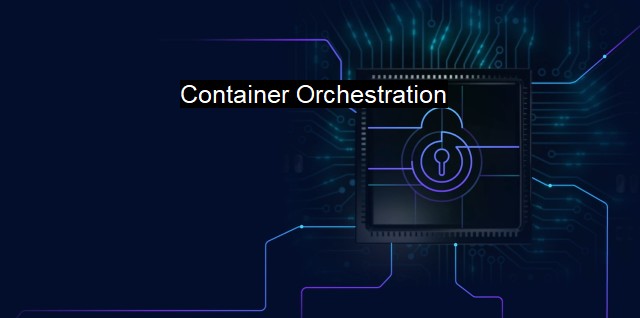What is Container Orchestration?
Improving Software Deployment and Security with Container Orchestration: An Overview of Benefits and Best Practices
Container orchestration is a process that automates the provisioning, deployment, scaling, and management of applications, particularly those running in containerized environments. Containers are lightweight, standalone, executable software packages that include application code, runtime, system tools, libraries, and settings. They offer an efficient approach toward packaging, distributing, and runtime management of software applications. One advantage of container orchestration is that it enables the application to function uniformly and consistently across different computing environments.In the landscape of cybersecurity and antivirus, the relevance of container orchestration cannot be overstated. Many aspects of container orchestration -- including declaring the desired state of application instances, deployment tasks, health checks, and scaling -- play a significant role in maintaining the security of the application environment.
One of the key benefits of container orchestration is its ability to automate security patching across a broad spectrum of running containers, thus reducing the window of vulnerability from outdated software or libraries. By design, container-based environments encourage frequent updates and disposability of environments rather than long-term maintenance of long-running servers that could increase the risk of unpatched vulnerabilities.
Container orchestration provides isolation of resources which reduces the possibility of attack spread if one application is compromised. The stern use of namespaces and cgroups ensures compartmentalization of processes, thus limiting the possibility of an attack sprawling across an entire system from just one compromised application.
Most container orchestration tools provide features for secrets management. Secrets are vital in managing sensitive data such as APIs and login credentials. By incorporating secrets management into a well-designed orchestration system, we minimize human exposure to sensitive data, reducing potential attack vectors.
Modern container orchestration systems can also help provide critical elements such as network policy enforcement and firewalling capabilities between container groups. By putting up secure parameters early on, one adopts a proactive approach to cybersecurity which prevents malicious attacks before they occur.
Orchestration platforms also automate scanning for vulnerabilities, monitor container activity for unusual behavior, and provide visibility of the ongoing situation to the application administrators, hence enforcing strong security practices as part of day-to-day operations.
It's important to highlight potential pitfalls of container orchestration in cybersecurity. Misconfigurations in orchestration tools can introduce vulnerabilities exploited by malicious actors. failure to follow best practices, like allowing unsecured access to the orchestration platform's dashboard, can risk exposing systems and data at scale.
Its streamlined approach to managing containers plays a fundamental role in strengthening the security apparatus of an organization dealing with large-scale, complex application environments. When integrated with a suite of tools such as vulnerability scanners, runtime security agents, and logging and monitoring setups, container orchestration can form the backbone of an enterprise-grade, cybersecurity defense.
The convenience and added cybersecurity benefits that container orchestration offers doesn't engender complacency. Teams need to apply cybersecurity basics, such as routine audits, to their orchestration environments. Looking at configurations with a critical eye and practicing access management diligently can prevent a host of security issues.
While the complexities of incorporating container orchestration into an organization's operations may seem daunting, it is an essential tool in the modern era of cloud computing and is imperative for robust cybersecurity operations. By embracing container orchestration, organizations can reap rewards of efficiency and scalability, boosting their cyber defenses through robust isolation mechanisms, vulnerability management, secure network policies, and intensive monitoring capabilities.

Container Orchestration FAQs
What is container orchestration and how does it relate to cybersecurity and antivirus?
Container orchestration refers to the process of managing and automating the deployment, scaling, and operation of containers in a containerized environment. Container orchestration is relevant to cybersecurity and antivirus because it allows for efficient management of security updates and antivirus scans across multiple containers, ensuring that all containers are secure and up-to-date.How can container orchestration help improve security in a containerized environment?
Container orchestration can improve security in several ways. Firstly, it allows for easy management and distribution of security patches and updates across multiple containers. Secondly, it enables automated deployment of security policies, such as network segmentation and access controls. Finally, container orchestration tools can monitor containers for security vulnerabilities and automatically take actions to mitigate them, such as isolating compromised containers or blocking malicious traffic.What are some popular container orchestration platforms?
There are several popular container orchestration platforms available, including Kubernetes, Docker Swarm, Mesos, and Nomad. These platforms provide a range of features and capabilities for managing containers, such as automated scaling, load balancing, health monitoring, and more.How do I choose the right container orchestration platform for my organization?
Choosing the right container orchestration platform depends on a variety of factors, including your specific use case, level of technical expertise, and budget. It's important to evaluate each platform's features and capabilities, as well as its deployment options and compatibility with your existing infrastructure. Additionally, consider the level of community support and availability of resources and documentation for each platform. Ultimately, the right container orchestration platform will depend on your unique needs and requirements.| | A | | | B | | | C | | | D | | | E | | | F | | | G | | | H | | | I | | | J | | | K | | | L | | | M | |
| | N | | | O | | | P | | | Q | | | R | | | S | | | T | | | U | | | V | | | W | | | X | | | Y | | | Z | |
| | 1 | | | 2 | | | 3 | | | 4 | | | 7 | | | 8 | | |||||||